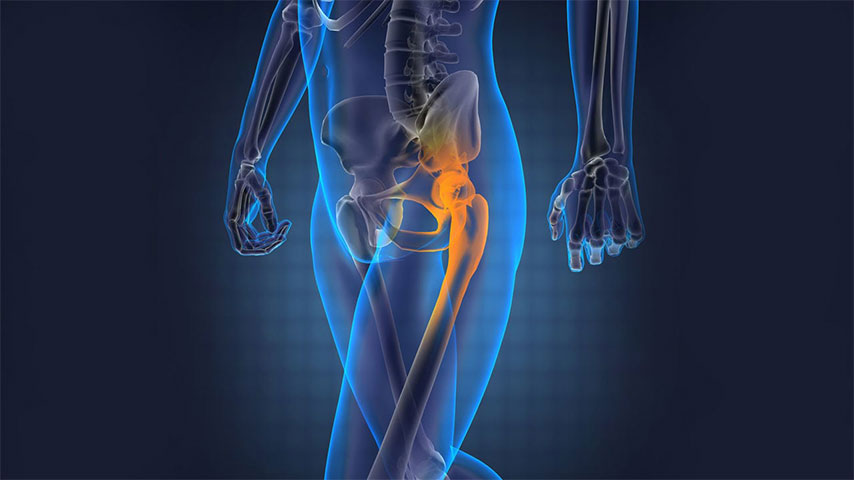
Avascular necrosis femoral head treated through Marmas..!
Avascular necrosis, osteonecrosis, aseptic necrosis, or ischemic bone necrosis are the names of the condition where in our bone tends to collapse due to lack of proper blood supply.
Pain and restricted motion of hip
Avascular Necrosis of the Femoral Head is a progressive weakening of the head of femur, and if due care is not taken in time ultimately it results into the collapse of bone structure. AVN femur is caused due to disrupted circulation leading to necrosis (cellular death) of bone cells that maintain the solid bone matrix. It is seen in children and young adults as a result of injuries specially fractured femur neck (which are the more common cause of AVN) and genetic bone disorders. It may occur later in life due to abuse of drugs (mainly corticosteroids and alcohol) and secondary to some chronic diseases that affect the vascular system. It is estimated that more than 10,000 new cases of AVN femur head are diagnosed in the U.S. each year.
It is usually diagnosed when a patient complains of pain and restricted motion of the hip, where the pain is worsened with movement and improved with the rest. One or both hips can be involved but in cases other than traumatic injury, one side is affected first and the other may develop the condition later. Symptoms of AVN of femoral head are presented by groin or hip pain radiating to buttocks, anteromedial thigh or knee that is aggravated by weight-bearing and sometimes by coughing. Progressive increase of the pain worsens with time and use, patient experiences pain on rest which may be worse during night and may have association with morning stiffness. Surgical replacement of the femoral head is the primary therapy, undertaken when day-to-day activities become impaired. But surgical intervention has its own complications and limitations and hence many patients tend to avoid it.
Ayurveda & Marma : Non-invasive treatment
In Ayurveda Asthi-majjagata vāta, vātavyādhi, occurs due to the vitiated vāta doṣa residing in asthi (bones) and majjā (marrow). It presents with the clinical features as bhedo-asthiparvaṇāṃ (breaking type of pain in bones), sandhishūla (joint pain), satata ruk (continuous in nature), māṃsabalakṣaya (loss of strength and muscles weakness) and asvapna (disturbed sleep), which correlates with symptoms of AVN femur head.
Marma therapy which is ancient non-pharmacological, non invasive techniques has increasingly being used nowadays. Marma therapy is the art of stimulating some important sites on individual’s body for rechannelization of vital energy (Prana) at a critical moment of time for purpose of healing. Stimulation of vital energy points have been proven (by measuring them both in biochemical studies of blood and Cerebrospinal Fluid) to release endogenous opioids viz Endorphins, Enkephalins, Dynorphins, and increases production of neurotransmitters such as Serotonin and GABA (Gamma Amino butyric Acid) and regulates Cortisol the main stress hormone.
Hence Marma therapy which is less time consuming and rapid acting can be used as an alternative and/or adjuvant therapy for treatment of Avascular Necrosis Femur Neck and we have found encouraging results by this therapy even in Grade III and Grade IV AVN Femur Patients. Pain of the patients improved significantly and the gait improved as well. Patients had better QOL Score after treatment. Patients who had to leave their job due to excessive Pain and restricted range of movement were able to join their work within a period of One Month of starting the Marma Therapy Treatment.
Treatment given
The Marma Points stimulated on the patient were -
- Kshipra Marma
- Talhridaya Marma
- Gulf Marma
- Indrabasti Marma
- Kukundara Marma
- Katikatarun Marma
Each Marma is stimulated for 25-30 times in one sitting starting from Katikatarun Marma to Kshipra Marma in both lower limbs and back, followed with recommended 4-5 sitting daily to the patients. One of the major advantages of Marma Therapy is that it can also be taught to the patients to do on their own and hence highly cost effective. It can be done while Sitting, Supine, Prone Postures depending upon the type of Marma to be stimulated. The stimulation of the marma we do by application of adequate digital pressure at exactly the right position. Deep breathing exercises are performed prior to therapy to help the body relax and to locate the Marma Points with ease.
Along with Marma Therapy, Oral Ayurvedic medications viz Mahamanjishthadi Kwath, PhalaTrikadi Kwath and Singhnad Guggulu, Cap Asthiposhak were given for improvement of blood circulation, reduction in swelling and for strengthening the bones.

Add a comment